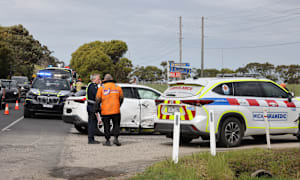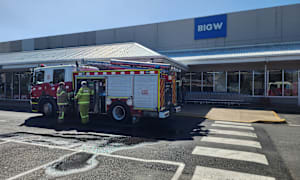IF AUSTRALIA didn’t already know about the significant dinosaur discoveries made along the coast from Inverloch to San Remo, they heard about it from two sources in the past week.
A key feature of the very well received ABC Back Roads program with Heather Ewart, focussing on the Bass Coast last Tuesday night, was our dinosaurs.
And on Sunday, September 8, details were released in ‘Alcheringa’, an Australasian Journal of Palaeontology, about newly-discovered footprints in the Wonthaggi Formation of theropod and ornithopod dinosaurs date back to the Early Cretaceous epoch, over 120 million years ago, when Australia was still connected to Antarctica.
These Early Cretaceous dinosaur footprints include 18 tracks made by medium to large theropods (0.8-1.9m hip heights) and four tracks made by small ornithopod dinosaurs (40-48cm hip heights).

According to one of those acknowledged in connection with the discoveries, Anthony J. Martin of the Department of Environmental Sciences, Emory University, Atlanta, Georgia, this latest find is something special.
“These numerous tracks are the best evidence yet that these former polar environments supported large carnivores,” said Professor Anthony Martin.
“The large theropods would likely have fed on prey such as smaller dinosaurs, fish and turtles.
“The hip height of that theropod would have been about the same as the full height of a tall, modern-day human.
“The Australian state of Victoria’s rocky coastal strata mark where the ancient supercontinent Gondwana began to break up around 100 million years ago, separating Australia from Antarctica.
“The polar environment at that time was a rift valley with braided rivers.”
“Although the mean annual air temperature was higher during the Cretaceous than today, during the polar winters the ecosystems experienced deep freezing temperatures and months of darkness.
“The Wonthaggi Formation has yielded one of the best assemblages of polar dinosaur body fossils in the southern hemisphere, but most of these remains are small fragments of bones and teeth.
“These fragments may have been carried to the site where they were buried by torrential spring floods.
“Our find of so many theropod tracks, however, confirms that a variety of dinosaurs actually lived and walked on the ground where their bones were found.
“Dinosaur tracks are actually much more common at the site than we previously realized.”
The theropod footprints in the Wonthaggi Formation range in length from 18 to 47cm (7-18.5 inches).
They are distinguished by relatively thin toes tipped with sharp claws.
The ornithopod footprints range in size from 10 to 18cm (4-7 inches).
The range in sizes of the tracks suggests a mix of juvenile and adult ornithopods and theropods.
“That indicates that these dinosaurs may have nested and raised their young in the polar environment,” Professor Martin said.
Background from Alcheringa
The Wonthaggi Formation (Valanginian-Aptian) in Victoria, Australia has one of the best assemblages of polar dinosaur body fossils in the Southern Hemisphere, but most remains are preserved as disarticulated bones and teeth, representing post-mortem transport in fluvial systems.
In contrast, the recent discovery of at least 24 tridactyl dinosaur tracks in the Wonthaggi Formation in the same places as their body fossils shows dinosaurs were living in these environments.
Nearly all dinosaur tracks are preserved as isolated structures in marine-platform exposures of overbank and floodplain facies, but with one partial theropod trackway recording two consecutive steps.
Based on forms and sizes, most tracks were made by medium to large theropods (0.8–1.9 m hip heights), with only a few small ornithopods (40–48cm hip heights) represented.
Relative abundances of theropod and ornithopod tracks are the inverse of Wonthaggi dinosaur body fossils, which are dominated by ornithopods, yet the ornithopod tracks are the first reported from the Wonthaggi Formation.
Two tracks (44 and 47cm long) are the largest known Early Cretaceous theropod footprints in southern Australia, representing theropod sizes comparable to the Australian megaraptoran Australovenator. These and other 30cm-long tracks further affirm the presence of large polar theropods previously inferred from scanty skeletal material. Because tracks are preserved in facies adjacent to channel sandstones, they were likely made by theropods and ornithopods traveling through those environments after spring-thaw flooding, such as during polar summers.










